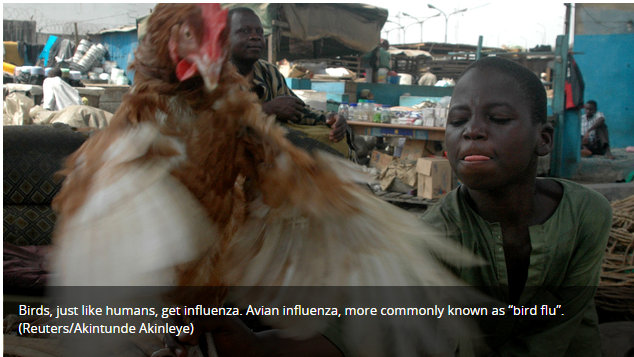The Government last week confirmed the outbreak of bird flu on some parts of Lake Victoria shores. The cases of death of wild birds, the white-winged black terns at Lutembe Bay that had persisted for about two weeks, were first reported to the Ministry of Agriculture, Animal Industry and Fisheries on January 2.
On January 13, another report came from Masaka where domestic ducks and chicken had died at Kachanga village in Bukibanga parish and Bukakata sub-county. The carcasses were delivered to the National Veterinary Diagnostic Laboratory in Entebbe. It was later confirmed that the deaths were due to bird flu.
READ: Ugandans panic as govt announces dangerous BIRD-FLU outbreak
ALSO READ: Bird-flu spreads as Kenya, Rwanda ban Ugandan chicken
Though Uganda does not have any human victims or suspects of avian influenza, also known as bird flu, according to Dr Anthony Mbonye, the director of health service (clinical and community health) at the health ministry, The Conversation Africa’s health and medicine editor Candice Bailey asked Dr Sibongile Walaza to explain the deadly virus.
How many different strains of bird flu are there? How different and potentially serious are they?
Birds, just like humans, get influenza. Avian influenza, more commonly known as “bird flu”, is an acute viral respiratory infection caused by influenza A viruses which spread from bird to bird.
The influenza A viruses are classified into subtypes according to the two types of proteins found on the outside of the viruses, also called spikes: haemagglutinin (H) and neuraminidase (N). The viruses use these spikes to attach and infect human cells. For example, there is avian influenza A(H5N1), A(H7N9) and A(H9N2). The most commonly known of these is avian influenza A(H5N1) viruses which are found in poultry.
There are a number of sub-types that have been circulating since regular monitoring for avian influenza viruses started. H5N1 viruses circulate in poultry in parts of Asia and northeast Africa. Avian influenza is also a problem in other countries including in Europe where millions of birds on farms have been culled. These have led to people being infected while working or handling infected birds or carcasses. The first fatal human cases were reported in 1997.
Are some strains of bird flu more dangerous for humans than other? Why?
Yes, some are more dangerous than others. There is highly pathogenic avian influenza (HPAI) and low pathogenic avian influenza (LPAI) based on the clinical illness caused in poultry. Highly pathogenic avian influenza viruses have the ability to spread fast through all organs of the birds or poultry causing a high number symptomatic illness and deaths in birds.
Low pathogenic avian influenza viruses usually cause asymptomatic illness in poultry and birds and can go undetected.
The highly pathogenic avian influenza virus H5N1 is also responsible for a high number of deaths in people infected with the virus.
How is bird flu passed onto humans? And once a human has contracted the flu can they transmit it?
Avian influenza strains do not normally infect humans, but some can. Three prominent influenza A viruses are known to infect people (H5, H7 and H9).
People can get infected in two ways. Through direct contact with live or dead birds infected with avian influenza or through indirect contact, for example being exposed to an environment that’s contaminated by products (like droppings) of infected birds.
Symptoms include a sudden onset of high fever, aching muscles, headache, severe sickness, a cough and a sore throat. Infected individuals can show symptoms from between two and up to 17 days after infection.
When it comes to human to human transmission, current epidemiological and virological evidence suggest that A(H5) and A(H7) have not acquired the ability to spread easily among people. But small clusters of A(H5) and A(H7) virus infections have been reported previously, especially among health care workers caring for patients with avian influenza.
How common are bird flu outbreaks in Africa? Where have the most severe outbreaks taken place?
There have been a number of outbreaks on the continent. Between 2014 and 2016 outbreaks of the H5N1 avian influenza were reported in west and central Africa. Several poultry farms in Cameroon, Niger, Burkina Faso, Ivory Coast, Ghana and Nigeria were affected. In 2006, a reported 3.5-million birds in Nigeria were killed by the virus or culled to stop its spread.
The first case of H5N1 bird flu infecting humans was detected in Hong Kong in 1997. Since then it has spread across Asia and to Europe and Africa. In some countries H5N1 in poultry has become endemic. More than 700 people from 15 countries have been infected with H5N1 – about 60% of these people have died. In Africa Egypt is the hot spot for highly pathogenic H5N1 outbreaks in poultry and has had the highest number of human cases and fatalities reported since 2003.
Sibongile Walaza, Medical Epidemiologist at the National Institute of Communicable Diseases and Lecturer at the School of Public Health, University of the Witwatersrand
The Conversation.











